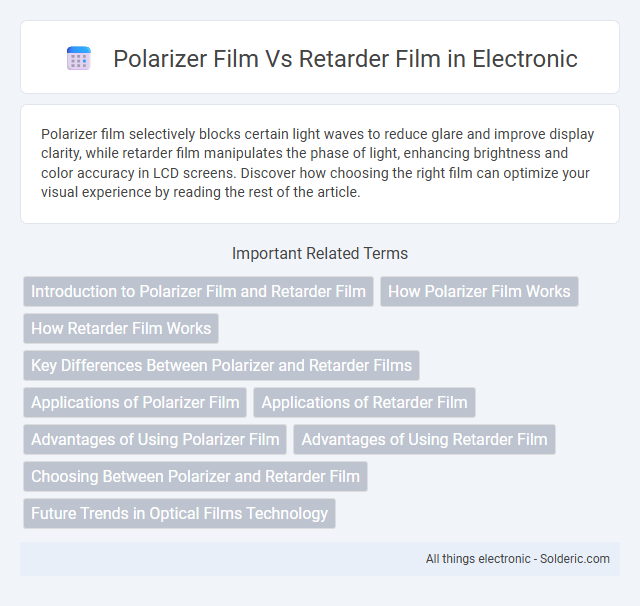Polarizer film selectively blocks certain light waves to reduce glare and improve display clarity, while retarder film manipulates the phase of light, enhancing brightness and color accuracy in LCD screens. Discover how choosing the right film can optimize your visual experience by reading the rest of the article.
Comparison Table
| Feature | Polarizer Film | Retarder Film |
|---|---|---|
| Primary Function | Filters and controls polarized light waves | Alters the phase of light polarization |
| Application | Used in LCDs, sunglasses, cameras | Enhances LCD viewing angles, 3D displays |
| Light Interaction | Blocks unwanted polarized light | Changes polarization state (e.g., linear to circular) |
| Material | Polyvinyl alcohol with iodine or dye coating | Birefringent polymer films like cellulose acetate |
| Thickness | Typically 50-100 microns | Varies, often precisely controlled for phase delay |
| Impact on Display Quality | Enhances contrast and reduces glare | Improves color accuracy and viewing angles |
| Cost | Generally lower cost | Relatively higher due to precision manufacturing |
Introduction to Polarizer Film and Retarder Film
Polarizer film controls light polarization by allowing only specific light waves to pass, enhancing visibility and reducing glare in displays. Retarder film modifies the phase of polarized light, enabling precise control over light retardation for improved optical performance in devices like LCDs. Both films are essential components in modern display and optical technologies, optimizing visual clarity and color accuracy.
How Polarizer Film Works
Polarizer film operates by filtering light waves, allowing only those oscillating in a specific direction to pass through, which reduces glare and improves visual clarity. It consists of molecules aligned in a particular pattern that blocks polarized light perpendicular to their orientation. This selective transmission makes polarizer films essential in applications like LCD screens, sunglasses, and camera lenses for enhancing contrast and visibility.
How Retarder Film Works
Retarder film works by altering the phase of polarized light waves, converting linearly polarized light into circularly or elliptically polarized light through controlled birefringence. This optical property enables retarder films to manage glare, enhance contrast, and improve the visibility of displays under various lighting conditions. Your choice between polarizer and retarder films depends on whether you need to filter polarized light or modify its phase for specific visual effects.
Key Differences Between Polarizer and Retarder Films
Polarizer films control light transmission by filtering specific polarization directions, enhancing display contrast and reducing glare, while retarder films modify the phase of polarized light to adjust its optical properties, such as reducing reflections or controlling birefringence. Polarizer films are essential in LCDs for regulating light intensity and clarity, whereas retarder films are used to improve viewing angles and color uniformity by altering polarization states. Your choice between these films depends on whether you need to filter polarized light or manipulate its phase for improved optical performance.
Applications of Polarizer Film
Polarizer film is widely used in LCD screens, cameras, and sunglasses to control light polarization and improve visual clarity by reducing glare and enhancing contrast. Its applications extend to scientific instruments and 3D glasses, where selective light filtering is essential. Your devices benefit from polarizer film technology by delivering sharper images and reducing eye strain.
Applications of Retarder Film
Retarder films are widely used in display technologies, such as liquid crystal displays (LCDs), to enhance brightness, contrast, and viewing angles by modifying the polarization state of light. These films enable optical compensation that corrects phase differences in LCD pixels, improving image quality on smartphones, televisions, and monitors. Beyond displays, retarder films find applications in optical instrumentation, glare reduction, and 3D projection systems due to their ability to control light phase retarding properties.
Advantages of Using Polarizer Film
Polarizer film enhances display clarity by reducing glare and improving contrast, making it essential for devices like LCD screens and sunglasses. Its ability to selectively block polarized light increases visual comfort and reduces eye strain, particularly in bright environments. Compared to retarder film, polarizer film offers more effective control over light polarization, contributing to better image sharpness and color accuracy.
Advantages of Using Retarder Film
Retarder film enhances display quality by improving color accuracy and viewing angles, making it ideal for advanced LCD and OLED screens. It reduces light leakage and minimizes reflection issues compared to polarizer film, resulting in clearer images under various lighting conditions. Retarder films also enable thinner, more energy-efficient displays by optimizing light polarization without significant brightness loss.
Choosing Between Polarizer and Retarder Film
Choosing between polarizer film and retarder film depends on the specific optical application, such as controlling light polarization or phase retardation in LCD displays or optical devices. Polarizer films are designed to selectively transmit light polarized in a particular direction, enhancing contrast and reducing glare, while retarder films manipulate the phase of polarized light to improve beeld quality and viewing angles. Understanding the functional differences and performance requirements of each film ensures optimal selection for applications in displays, optical sensors, and imaging technologies.
Future Trends in Optical Films Technology
Polarizer film and retarder film are evolving with advancements in nanotechnology and flexible materials, enhancing display efficiency and color accuracy for next-generation devices. Future trends emphasize integrating smart functionalities such as adaptive light control and improved energy efficiency, making these optical films crucial for AR/VR and foldable screen innovations. Your choice between polarizer and retarder films will increasingly depend on optimizing visual performance in compact, high-resolution displays.
Polarizer Film vs Retarder Film Infographic

 solderic.com
solderic.com